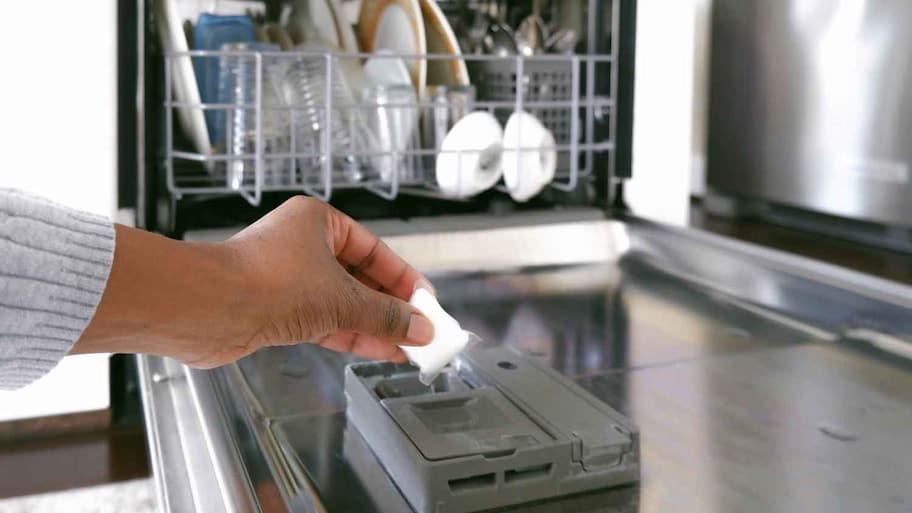Reasons Your Dishwasher Is Leaking from the Bottom and What to Do
Your dishwasher should be cleaning dishes—not the floor


Highlights
A damaged gasket can ruin the seal around your dishwasher door, causing leaks.
Inspect your dishwasher’s hoses for signs of looseness or damage.
You should check your appliances for signs of water damage every month.
Some homeowners insurance policies cover the cost of water damage repairs.
A home warranty plan may cover reparations for your appliances.
When a puddle of water mysteriously appears after you run the dishwasher, you’ll want to know exactly how to stop it before water damage strikes. While homeowners insurance can cover water damage, taking action before you have water damage is key to having your home clean, safe, and mold-free. Here are some of the most common reasons why your dishwasher is leaking from the bottom and what you can do to get to the root of the problem fast.
1. You Have a Damaged Gasket
The gasket is a rubber seal that surrounds the door of your dishwasher to prevent leaks from occurring. Rubber gaskets are prone to typical wear and tear, so they should be first on your list as you try to troubleshoot your leaky dishwasher. Inspect the gasket for signs of stretching, tears, deterioration, and mineral deposits to see if it's time to replace the gasket.
How to Fix It:
As one of the most common causes for a dishwasher leaking from the bottom, you're in luck when it comes to fixing your dishwasher. Gaskets are easy and affordable to replace. All you have to do is the following:
Buy the correct-sized door seal for your appliance.
Remove the old, faulty gasket.
Clean the door using mild soap and warm water.
Warm up the new door seal with a blow dryer set to low heat to remove creases.
Then, press the seal onto the sides of your door without stretching it.
2. The Latch Isn’t Latching

A broken, bent, or loose door latch can cause mayhem for your dishwasher’s seal. Without the latch, the door won't shut fully, increasing the likelihood of water leaking out of the dishwasher. In this case, water may look like it's leaking from the bottom of your dishwasher when in reality, it's running down the sides of your dishwasher.
How to Fix It:
If you have a loose latch, try using a screwdriver to tighten the latch. Bent latches may be able to be straightened out, but if that doesn't work, or your latch is broken entirely, then you'll need to replace the latch. Check the model and make of your dishwasher to find a compatible replacement latch. Most latches are easy to replace yourself, so hiring a professional to do the job will cost you more than it's worth.
3. There’s a Clogged Filter
Filters are great for catching food particles, but when your filter is clogged, this can cause your dishwasher to leak. Instead of the water draining as it should during a typical cycle, it can become backed up and leak out of your dishwasher’s basin.
How to Fix It:
You shouldn't have to do much to fix this issue. Simply clean the filter with soap and water to remove debris, mineral deposits, grease, and food particles. This is also a good time to clean the bottom of your dishwasher, as a clogged filter won't catch all of the food particles, leaving them to accumulate in your dishwasher.
4. You have a Faulty Dishwasher Hose

Having a loose or damaged dishwasher hose can cause large, noticeable leaks and pools of water under your dishwasher. Dishwasher hoses connect your dishwasher to the water supply. These connections can easily come loose or corrode over time and are a common reason for a dishwasher leaking from the bottom.
How to Fix It:
Look at the external and internal connections attached to your dishwasher to see if there are any signs of tears or corrosion. You can also gently move the hoses to see if they are loose. A loose dishwasher hose can be tightened, but a faulty dishwasher hose needs to be replaced with a compatible replacement part.
5. The Inlet Valve Needs Replacing
The inlet valves go hand-in-hand with dishwasher hoses. If you suspect an issue with the connections of your dishwasher, and it's not your hose, then the next area you should inspect is the inlet valves. Inlet valves allow the water to enter your dishwasher from the hot and cold water hoses.
If the dishwasher inlet valve breaks or becomes loose, then you'll notice a decrease in the speed at which your dishwasher fills and how well your dishwasher cleans your dishes on top of any leak.
How to Fix It:
Fixing the inlet valve may only be a matter of tightening the valve, but a broken inlet valve requires a replacement part. Replacing the valve is a straightforward and affordable fix. Just be sure to choose a compatible part according to your dishwasher’s make and model.
6. The Dishwasher Tub Is Broken
If you have a broken dishwasher tub, that means that the basin that holds the water and dish baskets is corroded or cracked. Like a cup with a crack at the bottom, any water in your dishwasher will quickly flow out the bottom of the appliance.
How to Fix It:
Some dishwasher tubs can be repaired with caulk and a little TLC. For larger cracks or extensive damage, you may need to replace the tub entirely. This may not be a cost-effective choice if your dishwasher is an older unit. Dishwasher tubs are more complex to replace than simply replacing an inlet valve, hose, or latch. So if your dishwasher is over 10 years old, you’re probably better off replacing it.
You might need a dishwasher repair technician to replace the tub, which can make the dishwasher repair cost more expensive than replacing the dishwasher.
7. You’re Using the Wrong Detergent

We've all seen a show or movie where someone puts too much detergent in a dishwasher or washing machine only for bubbles and water to spew out all over the floor. And, while this might not be exactly how using the wrong soap works, there's still something to be said about using an incorrect detergent or amount of detergent.
If you're using dish soap as a dishwasher detergent, this could be why your dishwasher is leaking from the bottom. Even using dish soap to gently clean your dishes before placing them in the dishwasher can add too much lather to a dishwasher if you don’t fully rinse soap residue off the dishes. All those suds can add too much pressure to the seal of your dishwasher door, leading to that infamous leak.
How to Fix It:
Try changing up your dishwasher detergent if you suspect that your detergent is too soapy. Don't pre-wash your dishes with dish soap prior to putting them in the dishwasher. And don't use more dishwasher detergent than the recommended amount when washing dishes.
8. Your Dishwasher Isn’t Level
A wobbly dishwasher can really shake things up—especially when it comes to water. If your dishwasher isn’t level, water has a higher risk of overflowing in the tub and leaking out beneath the machine.
How to Fix It:
To fix an unlevel dishwasher, put a level on the top of your dishwasher to first confirm that it’s not level. If you see that it’s not level, keep a mental note of which side is higher than the other. Then, you’ll need to unplug the appliance, unscrew the cabinet anchors, disassemble the panel and insulation, and adjust the legs of the appliance until the level is centered.
Since this fix requires several steps, you may prefer to work with an appliance technician to correctly uninstall, level, and reinstall the appliance.
9. Internal Parts of Your Dishwasher Need Repairing
Sometimes, there are internal parts inside your dishwasher that need repairing. If you can't find the source of the leak, and you've tried every other solution, then you may need a technician to come service your unit.
How to Fix It:
Fixing any internal issues will depend on the diagnosis from a technician. Many different types of issues can occur inside your dishwasher that may lead to it leaking from the bottom—with some problems being much easier to resolve than others. For example, a broken water pump requires more elbow grease than, say, replacing an interior hose.
No matter the cause, you should make it a monthly habit to check your appliances for signs of dampness, mold, and pooling water. This includes checking your water heater, dishwasher, washing machine, and refrigerator for leaks. Knowing how to check for mold in your home can save you on high water damage remediation costs down the line.
Repairing vs. Replacing your Dishwasher
Dishwasher repair costs $200 on average. Usually, if you only need to replace one or two faulty parts, fixing the dishwasher would be the better option. However, more complicated problems like a faulty control panel or a broken tub would cost much more to get fixed. Therefore, if the dishwasher is beyond repair, or if you have an older model that has been causing you trouble a little too often, you may consider replacing it.
A standard 24” built-in dishwasher costs between $400 and $1,200. Countertop options with smaller capacities are more affordable, ranging between $200 and $500. If you have a home warranty policy, the cost to replace your dishwasher is often covered.
DIY vs. Hiring a Pro
A broken dishwasher isn’t always the hardest problem to address. For example, if all you need to do is get a new filter, switch to a different detergent, or add some padding to level the appliance out, you can definitely handle the job yourself. Even replacing the inlet valve or the gasket can be done by yourself.
However, you should always hire a professional repair service if the damage is more severe or on the internal parts. A repairperson would also tell you if replacing your dishwasher is better. Also, if the dishwater has spilled, you will need to hire a water damage restorer to ensure the affected area and objects are thoroughly dried and disinfected. Water restoration for grey water costs about $5.25 per square foot.

